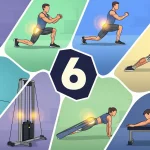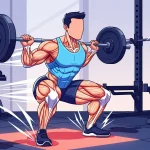Hey, Fit People! Have you ever seen someone do a backbend and thought, “Wow, that’s only for professional gymnasts!” Or maybe you’ve been curious to try it but felt hesitant because it looks so extreme? Don’t worry, you’re definitely not alone!
The backbend, also known as the wheel pose or Urdhva Dhanurasana in yoga, is an incredible full-body movement.
Although it looks challenging, the backbend comes with countless benefits for improving flexibility, strength, and mobility, all of which are essential for your overall fitness.
With the right preparation and technique, this movement can be a valuable addition to your routine. So #StayFocus on your mobility and strength goals, and let’s get to know the backbend better!
What Is a Backbend?
The backbend is a pose where the body arches backward like a bridge or a bow, with both hands and feet supporting the body on the floor. It is an intense movement that activates multiple muscles at once.
Muscles Involved:
When performing a backbend, several major muscles work hard, including:
- Back muscles (erector spinae): Responsible for extending and bending the spine.
- Glutes and hamstrings: Provide power and hip stability.
- Shoulders and triceps: Act as the main support and help lift the body.
At the same time, the backbend stretches the abdominal muscles, hip flexors, chest, shoulders, and quadriceps.
It is important to remember that this is an advanced movement that requires both flexibility and strength as a foundation. It is not something you should attempt without preparation.
Incredible Benefits of the Backbend for Fit People
Do not think that the backbend is only for showing off flexibility. This movement offers a wide range of benefits:
1. Improves Spinal Flexibility
The backbend helps open and lengthen each vertebra, reducing stiffness often caused by sitting too long. A flexible spine supports good posture and can ease chronic back pain.
2. Strengthens Core and Back Muscles
To hold the arched position, your abs, lower back, and glutes must work extra hard. This strengthens your overall core stability, which is the foundation for all functional movements.
3. Builds Strong Shoulders, Arms, and Wrists
Your hands and arms act as pillars in the backbend. Practicing it strengthens the shoulders, triceps, and wrist stability.
4. Opens the Chest and Hip Flexors
If you sit often, your chest and hip flexors tend to tighten. The backbend deeply stretches these areas, improving mobility and even expanding lung capacity by opening the chest.
5. Boosts Energy and Reduces Stress
Backbends are often linked with increased blood flow to the brain and the release of endorphins. Many people report feeling more energized, uplifted, and less tense after practicing.
6. Improves Posture
By stretching the spine and strengthening supporting muscles, the backbend helps correct slouched posture, making you stand taller and more confident.
Preparation and Safe Technique for the Backbend
Before attempting a backbend, warming up and stretching are crucial to prevent injury.
Focus on stretching the hip flexors, chest, shoulders, and spine. Useful prep poses include:
- Cat-Cow Pose: Warms up the spine.
- Bridge Pose: Builds a foundation for the glutes and lower back.
- Cobra or Upward-Facing Dog: Opens the chest and back.
- Camel Pose: For deeper stretches of the chest and hip flexors.
Basic Technique for the Backbend (Step by Step):
- Starting Position: Lie flat on your back. Bend your knees, place your feet flat on the floor close to your glutes. Place your hands beside your head with fingers pointing toward the shoulders and elbows bent upward.
- Lift the Hips: Take a deep breath. Press your hands and feet firmly into the floor together. Lift your hips and back off the ground.
- Push the Chest Forward: As you rise, press your chest toward the wall in front of you. Straighten your arms and legs as much as possible without locking the joints. Aim for an even arch from shoulders to hips.
- Breathe: Keep breathing deeply and steadily while holding the pose. Do not hold your breath.
- Coming Down: To exit, slowly bend your elbows and knees. Lower your body gradually, starting from the upper back, then mid-back, and finally the hips. Hug your knees to your chest afterward to release tension.
Safety Tips and Progressions
- Do not push yourself too hard. Go only as far as your body allows. Flexibility will improve over time with consistent practice.
- Listen to your body. If you feel sharp pain, especially in your lower back or neck, stop immediately.
- Start with easier poses such as Bridge Pose to build strength and flexibility.
- Use support if needed, such as practicing against a wall or with a Personal Trainer for guidance.
- Focus on breathing. Deep breaths help you relax and stretch more effectively.
Conclusion: #StayFocus on Flexibility and Unlock Your Full Strength
The backbend shows that fitness is not only about lifting heavy weights or running fast. It is also about flexibility, mobility, and the body’s ability to move functionally.
Mastering the backbend means unlocking incredible potential, building strength and flexibility at the same time. This movement is not only for gymnasts but for all Fit People who want to improve mobility and spinal health.
At Grand Focus Fit, we support you in every step of your fitness journey, including when you want to conquer challenging movements like the backbend.
We provide a spacious stretching area for flexibility practice, and our Professional Personal Trainers are ready to give one-on-one guidance for safe and effective techniques. They can also design programs to build the strength and flexibility foundation you need.
We are here to help you #StayFocus, not just on building muscles but also on flexibility, mobility, and spinal health.
Grand Focus Fit: Focus On Your Best Version!





